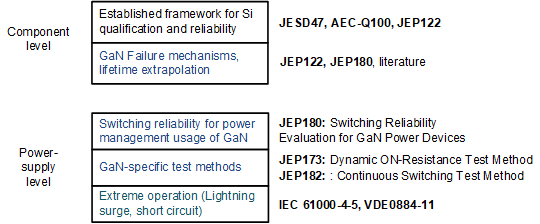SNOAA68 June 2021 LMG3410R050 , LMG3410R070 , LMG3410R150 , LMG3411R050 , LMG3411R070 , LMG3411R150 , LMG3422R030 , LMG3422R050 , LMG3425R030 , LMG3425R050 , LMG3522R030-Q1 , LMG3526R030
1 Introduction
For a new technology to be successful, it must be reliable in the customer application. Silicon power transistors are now regarded as reliable, but this was not always the case. Confidence in their reliability developed with longstanding experience, resulting in a well-accepted qualification methodology whereby reliability and quality are certified by running standardized tests and using reliability models for lifetime calculations. These tests were developed to accelerate failure mechanisms, with reliability engineering conducted to achieve the desired lifetime.
GaN transistors have now been known for 28 years(1). RF GaN FETs are now widely deployed in cellular base stations. Power GaN FETs are more recent, with development efforts starting in the early twenty first century. The power GaN industry does not have the luxury of time, so has invested considerable effort to accelerate reliability development. As a result, power GaN FETs are now considered reliable and are being deployed in both commercial and automotive products.
 Figure 1-1 GaN reliability is validated
by supplementing well-established standards with recent JEDEC JC-70 GaN
guidelines to cover both component and power-supply level operation.
Figure 1-1 GaN reliability is validated
by supplementing well-established standards with recent JEDEC JC-70 GaN
guidelines to cover both component and power-supply level operation.A key criterion is the reliable product operation for a broad range of customer applications under both normal and extreme use conditions. The traditional silicon approach, does not adequately address the switching conditions of power management, so we have built upon it. Our approach is shown in Figure 1-1, and consists of GaN-specific methodology to address switching reliability, conduct test, address failure modes, extrapolate lifetime, and ensure operation under extreme conditions such as lightning surge and short circuit.
The methodologies of Figure 1-1 result from several other aspects important for technology maturity. First is the formation of the JEDEC JC-70 committee on Wide Bandgap Power Electronic Conversion Semiconductors, with three GaN-specific guidelines already released: JEP173, JEP180, and JEP182. Second is the creation of a body of literature on failure mechanisms and their acceleration. Third is the thought leadership around a common approach for application reliability, a challenging topic. TI has played a leadership role in all these aspects. As a result, TI GaN products incorporate a well-developed methodology to validate and assure the reliability of GaN under all conditions of operation.
The objective of this white paper is to describe the progress and methodology by which TI GaN product reliability is assured and to show results that demonstrate lifetime reliability in application.